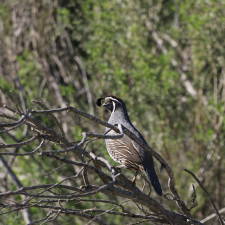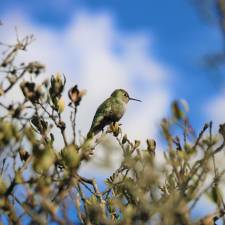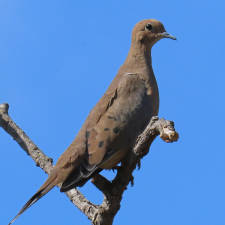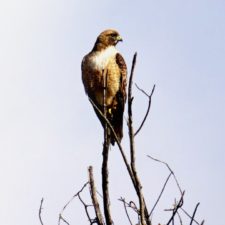While hiking on the trails in Aliso and Wood Canyons Wilderness Park, I heard a bird call. I looked up and was able to capture a pretty cool video of what I later learned was a red-tailed hawk as he continued to shriek, perched high on a sycamore tree.
I kept that video for quite a while, and when I recently got a new phone, I was able to do what I’ve been wanting to do: replace my Straight Outta Compton text-tone, which I do love, with something entirely new, the cry of a red-tailed hawk. Extracting the audio from the video and then converting it in Garage Band to a usable text-tone wasn’t easy. Once done, I was very proud and loved frequently hearing the majestic sound of such a beautiful bird. Sitting in our new headquarters in the canyon, if my text-tone went off, it tricked even the most trained of my co-workers to think there was a red-tailed hawk nearby.
After a colleague commented that having such a tone randomly go off in the wilderness may not be such a good a thing, I was faced with the obvious. Although just last week, I had witnessed a fellow hiker use a phone app to play a roadrunner call as we spotted a pair of roadrunners in the brush, I was surprised I hadn’t understood this sooner. I saw firsthand how that recorded call changed the roadrunners’ behaviors before my very eyes.
To learn more, I turned to a few resources, including David Allen Sibley’s The Sibley Guide to Bird Life & Behavior. Mr. Sibley states early in his massive book, under a section called Ethics: “The widespread and easy availability of birdsong recordings makes it easy for anyone to play recording in the field, which often elicits a response from the birds. This artificially alters the birds’ behavior and therefore has an undeniable impact on them. In certain cases, the impact may be significant, either distracting a bird from more important chores, using energy that it needs for other things, or even luring it into the open where it can be captured by a predator.”
In the hawk section of the book, Mr. Sibley states: “Hawks’ calls are not often heard outside the breeding season or away from the nest. In breeding season, they may call to signal alarm or location, to beg for food, to solicit copulation, or while engaged in aggressive encounters and territorial defense.”
Nesting season in our area is coming up for most local birds. It lasts from mid-February to summer’s end. For those of us who have used a recording of a bird, inadvertently as I have or while birding, let us all keep in mind the lesson I’m learning: when a bird hears a recording, it can’t necessarily tell that the sound is recorded. As such, the bird may respond unnecessarily to protect its territory. It may respond to the fake call at the expense of survival activities such as preening, foraging and caring for its young.
Laguna Canyon Foundation has many restoration sites in the wilderness parks and in the open space. We are deeply dedicated to minimizing impacts to breeding and nesting birds. We have trained staff with multiple years of experience that work diligently to ensure that restoration activities are done with limited disruption to the wildlife and provide long-term benefits to the habitat.
The American Birding Association Code of Birding Ethics includes:
- Support the conservation of birds in their habitats
- Avoid stressing birds or exposing them to danger…limit the use of recordings
- Minimize habitat disturbance…stay on trails
- Familiarize yourself with and follow all laws, rules and regulation.
Indeed, Mr. Sibley emphasizes to his readers that, “…using playback is illegal in all US national parks and national wildlife refuges, and in many local parks.”
I am reminded how I obtained the original recording of my text-tone in the first place. I was hiking, on-trail, quietly and alone. I heard the hawk’s call, respected his environment and from a distance was able to create a video of him.
Later, I learned from co-workers, more skilled and learned than I in this area, what damage I may be doing with my hawk recording. I have since changed my text-tone to Benedict Cumberbatch’s “Text me.” My phone is on vibrate when I hike.
Please enjoy the photo gallery. These photos were taken by my wonderful colleagues as they patiently and quietly waited in the field for the rare opportunity to capture such beautiful creatures on film.
To learn more, join our knowledgeable volunteers on our next Bird Walk. Sign up here.
Photos by Josie Bennett, Cameron Davis, Diane Etchison, and John Foley.








